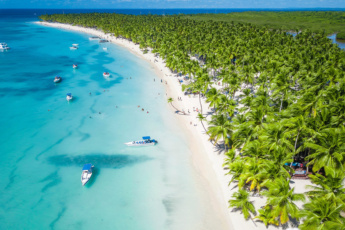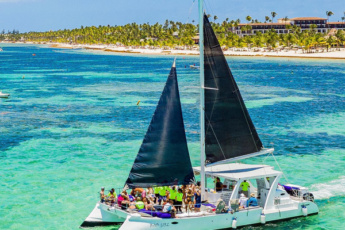Planning for Seasonal Changes: The Best Time to Visit the Dominican Republic and Why
Understanding the Climate of the Dominican Republic

Planning for Seasonal Changes: The Best Time to Visit the Dominican Republic and Why
The Dominican Republic is more than just a tropical paradise; it’s a vibrant tapestry of climates that can significantly influence your travel plans. From sunny beaches to lush mountains, understanding the country’s diverse climate zones will help you choose the best time to visit and what experiences await you.
1. Tropical Climate and Its Variations
The Dominican Republic boasts a tropical climate, characterized by warm temperatures and abundant sunshine throughout the year. However, this is not a one-size-fits-all scenario. The island’s geography creates several distinct climate zones influenced by elevation and proximity to the coast. For instance, the coastal areas experience more humidity and heat, while the mountainous regions, like the Central Cordillera, enjoy cooler temperatures and refreshing breezes, especially at higher elevations.
The north coast, with its lush tropical forests, experiences more rainfall and boasts a subtropical climate, while the southern regions, including popular tourist destinations like Punta Cana and Santo Domingo, enjoy a drier climate, making them perfect for beach-goers. Understanding these variations means you can tailor your visit to suit your preferences, whether you’re looking for vibrant nightlife in the city or tranquil nature escapes in the hills.
2. Rainy vs. Dry Seasons
The Dominican Republic has a clear distinction between its rainy and dry seasons, which can greatly impact your travel experience. The dry season typically runs from December to April, coinciding with the peak tourist season. During this time, you can expect bright sunny days and minimal rainfall, ideal for outdoor activities, beach lounging, and exploring the island’s rich culture.
On the flip side, the rainy season spans from May to November, where showers are more frequent, particularly in the afternoons. However, don’t let the thought of rain deter you! The wet season brings its own charm, with lush landscapes and fewer tourists. Moreover, prices for accommodations and activities tend to drop, making it a great time for budget-conscious travelers to explore the island without the crowds.
3. Temperature Ranges Throughout the Year
If you’re planning your trip, knowing the average temperatures month by month is crucial for ensuring a comfortable visit. The Dominican Republic typically experiences warm temperatures year-round, but there are slight variations. Here’s a quick breakdown of average temperatures:
Average Monthly Temperatures
| Month | Average High (°F) | Average Low (°F) |
|---|---|---|
| January | 82 | 68 |
| February | 83 | 68 |
| March | 84 | 69 |
| April | 86 | 71 |
| May | 87 | 73 |
| June | 88 | 75 |
| July | 89 | 76 |
| August | 89 | 76 |
| September | 88 | 75 |
| October | 86 | 73 |
| November | 84 | 71 |
As you can see, temperatures tend to peak in the summer months of July and August, making it essential to plan your outdoor activities accordingly. If you prefer milder weather, the cooler months of January through March are ideal for sightseeing and outdoor adventures.
By understanding the Dominican Republic’s climate, you can make informed decisions about when to visit and what to expect, ensuring a memorable and fulfilling travel experience.
Peak Tourist Seasons: When to Go for the Best Experience
Planning a trip to the Dominican Republic is an exhilarating journey filled with possibilities, and understanding the peak tourist seasons can significantly enhance your experience. Timing your visit not only affects the weather and activities available but also influences your budget and the overall vibe of your vacation. Let’s dive into the ins and outs of the peak tourist seasons and discover the best times to enjoy this Caribbean paradise!
1. High Season: December to April
The high season in the Dominican Republic runs from December to April, coinciding with the winter months in the United States and Canada. This period attracts a significant influx of tourists seeking to escape the chilly weather, and for good reason! During these months, visitors can expect ideal weather conditions—a delightful blend of warm temperatures, low humidity, and minimal rainfall.
This peak tourist season is characterized by vibrant energy, as resorts and attractions are bustling with visitors. Expect lively beach parties, a plethora of activities, and a lively atmosphere that makes for a memorable trip. However, a word of caution: with the increased demand during this time, prices for flights and accommodations can skyrocket. To maximize your experience without breaking the bank, it’s advisable to book your travel arrangements well in advance.
2. Low Season: May to November
On the flip side, the low season spans from May to November, and while it may be less crowded, it offers a unique charm that adventurous travelers should consider. This is when the weather begins to shift, and the island experiences its rainy season, particularly from August to October. However, don’t let the word “rainy” deter you; the showers often come in short bursts and can be a refreshing break from the tropical heat.
Visiting during the low season comes with numerous advantages. For one, you’ll find significantly lower prices on accommodations and activities, making it a budget-friendly option. Additionally, the beaches and attractions are much less crowded, allowing for a more peaceful and intimate experience with the stunning surroundings. You’ll have the chance to engage more authentically with locals and explore the rich culture without the hustle and bustle of peak tourist traffic.
3. Festivals and Events to Consider
When planning your visit, it’s essential to consider the vibrant cultural scene in the Dominican Republic. Throughout the year, various festivals and events take place, offering travelers an authentic taste of local life. Here are a few noteworthy events:
– **Carnaval** (February): A lively celebration filled with parades, music, and vibrant costumes, especially in Santo Domingo and La Vega.
– **Festival del Merengue** (July): Celebrating the country’s national dance with music, dance, and food in the streets of Santo Domingo.
– **Día de la Restauración** (August 16): A national holiday honoring the restoration of the Dominican Republic’s independence, featuring parades and public celebrations.
Attending these events can enrich your experience and provide unforgettable memories. Make sure to check the local calendars and align your travel dates to partake in these colorful festivities!
Highlighting the best times to visit can transform your trip into an extraordinary adventure. Whether you prefer the vibrant energy of the high season or the tranquil charm of the low season, the Dominican Republic has something to offer for every traveler.
Our Best Tours in Punta Cana

Saona Island Excursion - Caribbean Paradise
from $75 Read more
Swimming with Dolphins in Punta Cana - Top Adventure 2025 (50 minutes)
from $149 Read moreActivities and Attractions by Season
Planning a trip to the Dominican Republic? Understanding the seasonal activities and attractions can significantly enhance your travel experience, ensuring you make the most of your visit!
1. Beach Activities in Dry Season
The dry season, which typically spans from December to April, is the pinnacle of beach activities in the Dominican Republic. With the sun shining relentlessly and warm temperatures averaging between 75°F to 85°F, it’s no wonder that tourists flock to the stunning coastlines.
During this period, you can indulge in various water sports, including snorkeling, scuba diving, and kitesurfing. The crystal-clear waters are perfect for exploring the vibrant coral reefs teeming with marine life. Popular spots like Punta Cana and Puerto Plata offer rental services and guided tours, making it accessible even for first-timers.
Moreover, beach events such as bonfire parties, volleyball tournaments, and live music festivals add a festive atmosphere, inviting visitors to engage with the local culture while basking in the sun. For families, kid-friendly beach clubs often provide safe environments for children to play and explore.
2. Nature and Adventure in Wet Season
Contrary to popular belief, the wet season, extending from May to November, is an opportune time for nature lovers and adventure seekers. The rain rejuvenates the landscape, leading to lush greenery and vibrant ecosystems, making it ideal for hiking and eco-tours.
One of the highlights during this season is the opportunity to visit breathtaking waterfalls such as El Limón and Dudu Lagoon. The sound of cascading water and the surrounding flora create an enchanting atmosphere. Additionally, exploring national parks like Jaragua and Los Haitises allows for unique wildlife encounters, including sightings of endemic bird species and other exotic creatures.
Adventurous travelers can also take advantage of the less crowded hiking trails and enjoy activities like zip-lining and rafting. Many tour operators offer special packages during the wet season, often at reduced prices, making it an excellent time for budget-friendly exploration.
Cultural Experiences Year-Round
Regardless of the season, the Dominican Republic is rich in cultural experiences waiting to be uncovered. Museums, local markets, and historical sites are accessible year-round, providing travelers with a deep dive into the island’s vibrant heritage.
Cities like Santo Domingo, the capital, boast historical landmarks such as the Colonial Zone, a UNESCO World Heritage site. Here, visitors can explore the oldest cathedral in the Americas, Catedral Primada de América, and various museums showcasing the nation’s history and art.
Local markets, like the bustling Mercado Modelo in Santo Domingo, offer a sensory overload of sights, sounds, and flavors. Travelers can sample traditional dishes, purchase handmade crafts, and interact with friendly vendors, providing a genuine taste of Dominican culture. Whether it’s the vibrant Carnival celebrations in February or the lively Merengue Festival in July, there’s always something happening to enrich your travel experience.
From thrilling beach activities in the dry season to adventurous eco-tours during the wet season and year-round cultural experiences, the Dominican Republic has something to offer every traveler. Plan wisely to make the most of your visit!
Exciting Tours and Activities Await You
| Activity | Best Season | Location | Duration | Price Range |
|---|---|---|---|---|
| Scuba Diving | Dry Season | Punta Cana | Half Day | $75-$150 |
| Zip-lining | Wet Season | Jarabacoa | 2-3 Hours | $50-$100 |
| Cultural Tour | Year-Round | Santo Domingo | Full Day | $40-$80 |
Planning for Weather-Related Considerations
When planning your trip to the Dominican Republic, understanding the potential weather-related challenges can enhance your experience and ensure your safety. With its tropical climate, the Dominican Republic offers a variety of weather patterns that can impact your travel plans.
1. Hurricane Season: What to Know
The hurricane season in the Dominican Republic typically runs from June 1 to November 30, peaking between August and October. While hurricanes are not a daily occurrence, it’s essential to stay informed about the weather forecasts during this time. The Caribbean region has been affected by storms in the past, which can lead to flight cancellations, limited beach access, and disruptions to outdoor activities.
Travelers should consider purchasing travel insurance that covers weather-related cancellations. It’s also wise to book accommodations that offer flexible cancellation policies. Monitor hurricane tracking websites and apps, such as the National Hurricane Center, to stay updated on any developing storms. Should a storm threaten, be prepared to adjust your itinerary, as resorts and businesses may close temporarily for safety.
2. Packing for Variable Weather
Understanding the seasonal weather patterns is crucial for packing appropriately. During the dry season (December to April), travelers can expect warm, sunny days with low humidity, making lightweight clothing, swimwear, and sun protection essentials. However, as the wet season approaches (May to November), temperatures can remain high, but sudden rain showers are common. Packing a light rain jacket or poncho, waterproof shoes, and quick-drying fabrics can make your trip more comfortable.
For evenings, especially during the cooler months, bring a light sweater or shawl, as temperatures can drop slightly. Don’t forget to pack insect repellent, especially in the wetter months, as mosquitoes can be prevalent. A good tip is to keep all your essentials in a waterproof bag to protect them from unexpected showers.
3. Health and Safety Tips for Different Seasons
Your health and safety are paramount when traveling, particularly in a tropical climate. During the dry season, ensure you stay hydrated, as the sun can be intense. Sunscreen is a must! Conversely, in the wet season, be aware of potential flooding in certain areas and take care when hiking or exploring nature trails; some paths may be slippery.
Additionally, be cautious of food and water safety. Stick to bottled water and avoid street food during the rainy season, as heavy rains can compromise local sanitation. Familiarize yourself with local medical facilities and keep a basic health kit handy, including medications for common ailments like headaches or stomach issues.
The Dominican Republic is a beautiful destination year-round, but being prepared for weather-related challenges will ensure a smoother experience. With the right knowledge and preparation, you can enjoy everything this stunning island has to offer.
Our Best Tours in Punta Cana

Punta Cana Private Boat Trip at the Best Price - 3-Hour Exclusive Tour with Snorkeling (from Jellyfish to Cabeza de Toro)
from $590 Read more
Power Cruise – Punta Cana Party Experience on the Bad Girl Catamaran
from $65 Read moreBudgeting for Your Trip Based on Seasonality
When planning your adventure to the stunning Dominican Republic, understanding how the time of year influences travel costs is essential. This knowledge can help you maximize your experience while keeping your budget intact. Let’s dive into how seasonal changes impact your travel finances.
1. Cost Differences Between Seasons
The cost of your trip to the Dominican Republic can vary significantly depending on the season you choose to visit. Generally, the peak tourist season runs from December to April, when travelers flock to the island to escape the cold winter months in the Northern Hemisphere. During this time, prices for flights, accommodations, and activities can soar, often reaching their highest levels of the year. For instance:
- Flight prices can rise by up to 30% compared to the low season, with many airlines increasing their fares due to high demand.
- Hotel rates can double or even triple in popular areas like Punta Cana and Santo Domingo during high season, especially around holidays.
- Tour and activity prices often reflect the peak demand, leading to higher costs for excursions such as whale watching, diving, or guided tours.
In contrast, the low season from May to November offers significantly lower prices. You may find flights and accommodations at up to 50% off, allowing you to stretch your budget further. It’s also worth noting that many local businesses run promotions during this period to attract travelers, so keep your eyes peeled for special deals.
2. Tips for Saving Money During Peak Season
If you find yourself traveling during the high season, don’t fret! There are plenty of ways to save without sacrificing your experience. Here are some savvy tips:
- Book early: Securing flights and accommodations well in advance can help you lock in better rates, as prices tend to increase closer to the travel dates.
- Consider lesser-known destinations: While Punta Cana is a hotspot, exploring areas like Samana or La Romana can lead to lower prices while still offering breathtaking views and activities.
- Utilize package deals: Look for travel packages that combine flights, accommodations, and activities at a discounted rate. These can often provide significant savings.
- Be flexible with your travel dates: Traveling on weekdays or during off-peak times can result in lower prices, so consider adjusting your itinerary to take advantage of this.
With a bit of planning, you can enjoy the best the Dominican Republic has to offer without breaking the bank, even during the bustling high season.
3. Maximizing Value in the Low Season
Visiting the Dominican Republic during the low season can be incredibly rewarding, not only because of the cost savings but also for the unique experiences it offers. Here’s how to make the most of your trip:
- Explore off-the-beaten-path attractions: With fewer crowds, you’ll have the chance to discover hidden gems like secluded beaches, local markets, and authentic restaurants.
- Take advantage of lower prices: Many attractions, tours, and accommodations offer discounted rates during the low season, allowing you to enjoy more for less.
- Engage with locals: With more time to interact with residents, you’ll gain insights into their culture and traditions, enriching your travel experience.
- Enjoy the natural beauty: The wet season brings lush landscapes, vibrant flora, and stunning waterfalls, making it an excellent time for eco-tours and nature hikes.
Traveling during the low season not only saves you money but also allows for a more intimate and authentic experience in the Dominican Republic.
Cost Comparison Table of Travel Seasons
| Season | Average Flight Cost | Average Hotel Cost (per night) | Activity Pricing | Overall Experience |
|---|---|---|---|---|
| Peak Season (Dec-Apr) | $600 | $250 | 20% higher | Very crowded, vibrant |
| Low Season (May-Nov) | $300 | $125 | 20% lower | Less crowded, relaxed |
Understanding these cost differences can help you plan not just a trip but an unforgettable experience to the Dominican Republic that aligns with your budget and expectations.
Planning for Seasonal Changes: The Best Time to Visit the Dominican Republic and Why
When planning a family vacation, timing can make all the difference. The Dominican Republic offers a vibrant blend of culture, adventure, and relaxation, but understanding the best times to visit, especially when traveling with kids, can elevate your experience significantly.
1. Best Family-Friendly Seasons
When considering a family trip to the Dominican Republic, the timing of your visit can greatly impact your enjoyment. The ideal periods for family-friendly travel often align with school holidays, allowing parents to maximize quality time together without the stress of juggling work commitments.
Typically, the December to April window is favored due to its dry weather and pleasant temperatures. Families flock to the island during this time, taking advantage of the beautiful beaches and outdoor activities. However, it’s essential to book accommodations early to ensure availability and avoid inflated prices during peak season.
Conversely, the low season from May to November can also offer unique family experiences, with fewer crowds and often more affordable rates. While this period does coincide with the rainy season, rain typically falls in short bursts, allowing for ample opportunities to explore the island’s attractions. This time can also provide a more authentic experience, as you’ll encounter fewer tourists and more local culture.
2. Kid-Safe Activities Year-Round
Regardless of when you choose to visit, the Dominican Republic is brimming with kid-safe activities that can make any family trip memorable. Many resorts offer kid-friendly amenities, including kids’ clubs and supervised activities, allowing parents some much-needed downtime.
- Beach Fun: Most resorts have shallow areas perfect for young children to splash around safely.
- Snorkeling Excursions: Family-friendly snorkeling tours are available, introducing kids to the vibrant underwater world in a safe and guided environment.
- Cultural Experiences: Visiting local markets, museums, or participating in traditional cooking classes can be educational and entertaining for the entire family.
- Adventure Parks: Places like Bavaro Adventure Park offer zip-lining, water slides, and animal encounters that appeal to kids of all ages.
For families with younger children, it’s crucial to plan activities that allow for flexibility and downtime. A well-paced itinerary can ensure that both kids and adults return home with cherished memories rather than travel fatigue.
3. Planning Family Budget for Different Seasons
Budgeting for a family vacation involves more than just the cost of flights and hotels; it requires an understanding of how seasonal variations can affect overall expenses. During the high season, families can expect to pay a premium for accommodations, activities, and dining, so early planning is key to snagging the best deals.
Here’s a breakdown of budgeting tips based on seasonal travel:
- Travel Off-Peak: If you can travel during the low season, you’ll find lower prices on flights and accommodations. Additionally, many attractions offer discounts during this time.
- Package Deals: Look for family package deals that include flights, hotels, and activities. These can often provide significant savings.
- Dining Strategies: Opt for all-inclusive resorts where meals are included, or explore local eateries for authentic and affordable dining experiences.
- Plan Free Activities: Take advantage of the natural beauty of the island. Many beaches and parks have no entry fees, allowing families to enjoy quality time together without breaking the bank.
By considering these seasonal factors and activities, families can craft a travel experience that is not only enjoyable but also economical, ensuring that every visit to the Dominican Republic is filled with adventure and lasting memories.
